Thursday March 29, we cast off the dock lines at Shilshole Marina in the early morning and headed north. It was 6:30am and still mostly dark, but we had the tide to catch – a super ebb to carry us towards Port Townsend.
Leaving on a big cruise is always a bit more of an anti-climax than we expect. Months of preparation culminates in the short simple action of leaving dock. Mostly our thoughts are of surprise and relief: “We’re really doing it!”, and “I’m glad all the hard work is done.” But we quickly settled into the cruising routine – the stress of the city melted away as we sailed north, and land life became a distant memory.
Our plan in early season sailing is always to ride the southerly winds north – but southerlies aren’t guaranteed. Fortunately, much like our 2016 ride to Port Ludlow then Watmough, we had a light southerly all the way from Seattle to Fort Worden (Port Townsend) to Watmough Bay (Lopez Island).

Downwind and northbound in the Strait of Juan de Fuca on a light south-easterly.
Fort Worden Park, Port Townsend
We had always wondered whether the 6 mooring balls in front of Fort Worden could make a decent overnight anchorage. They’re exposed to the shipping traffic of Admiralty Inlet, and southerly winds. We had heard mixed things about them – some people said it was fine, and others (a report in Waggoners) said he got rolled out of his bed all night.
In the evening, the wind became light as it usually does, and the current aligned our boat parallel to potential waves/swell. About 8pm a swell came along, from the ferry or a container ship, and heaved our boat through 10 degree rolls for quite a while – rolls big enough that stuff started sliding around on our counters. That was the biggest one; smaller ones happened 3-4 times through the night.
So we wouldn’t recommend overnighting at Fort Worden. On the plus side, the walking/hiking trails on shore are great and it’s a fun place to explore.

Sea otter on the park dock! He had caught a fish and was enjoying his meal, sneaking a glance at us occasionally (up on the elevated dock) to make sure we weren’t going to disturb his lunch.

San Juans, Watmough Bay (Lopez Is)
Friday we took off early to catch the ebb again and sailed through the Point Wilson turning circle on 6-9 kts of SE breeze. This time we planned our route better than our many previous Point Wilson boondoggles (#1, #2, #3, #4). Usually we point north and get swept northwest by the current, with barely enough wind to sail.
This time we pointed east to northeast, on a beam reach perpendicular to the shipping lanes, and got swept to the northeast corner of the turning circle by the 4 knot current. This is much better when going to Rosario Strait, for avoiding the ebb flushing you further out the Strait.
About halfway across the Strait of Juan de Fuca (JdF) the sun came out and it got so warm we had to take off all our foulweather gear and put on sunscreen. We had what was our best downwind JdF crossing ever, sailing 100% of the way, much of it in beautiful conditions.
The San Juans are sometimes called the banana belt of the Pacific Northwest. It’s remarkable how much the weather can improve in such a short distance. We left an overcast, rainy Port Townsend in the morning and by the time we were halfway across the Strait, the weather had dramatically changed to warm and sunny.
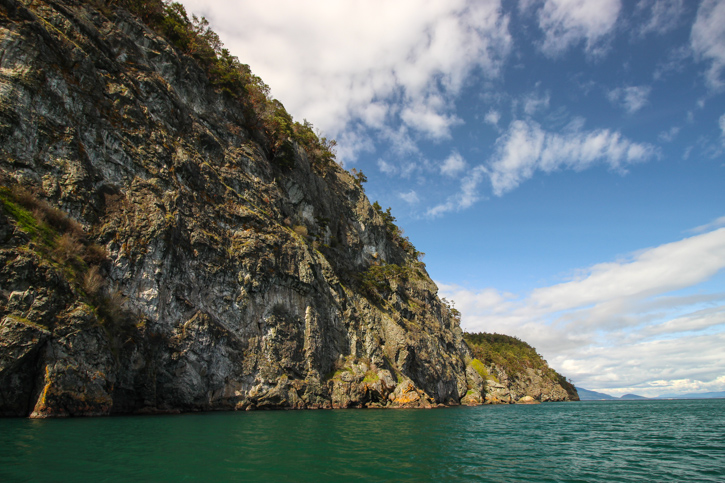
Watmough Bay, Lopez Island, looking out to the northeast.
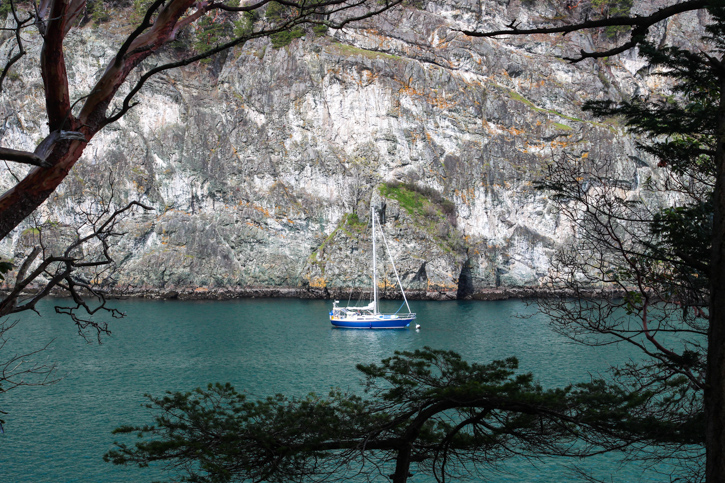
VIewing our boat from the hiking trail, with the tall imposing cliffs of Watmough Bay
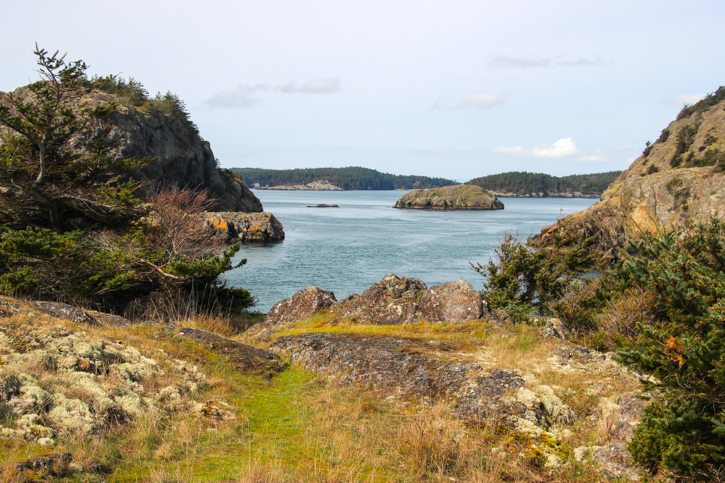
On a beautiful hike to the southwest of Watmough
Adjusting to the Cruising Routine
We’ve settled quickly into the cruising routine, leaving behind the stress of normal life as we left Seattle, and switching to that single-minded focus on the present you get while sailing.
One hard part about adjusting has been getting used to the new motion of the boat at anchor/moorings. Our first two nights were in pretty rolly anchorages, and as liveaboards at Shilshole we had gotten used to the boat being flat and stable. Marinas rarely have any side swell, and it takes over 20 knots of wind to get our boat heeling a bit there – but even that slight heeling is much less annoying than repetitive rolling every 5 seconds in an anchorage. It’s a reminder that picking non-rolly anchorages is pretty important to us.
We also haven’t fully broken free of the high information diet we’re used to in normal life with easy Internet access – email, news, social networks, etc. Some anchorages have no cellular data, and while that’s not a problem we think needs fixing (disconnecting is one of the best things about cruising), it takes some time to get used to.

Decatur Head, Lopez Island
The next day we anchored north of Decatur Head, amongst two dozen unused mooring balls. It was hot and sunny, so I did some paddleboarding and then we dinghied to the beach for happy hour. It really felt like summer in the San Juans. (Caveat: after a winter as liveaboards, 65 F feels hot to me!)
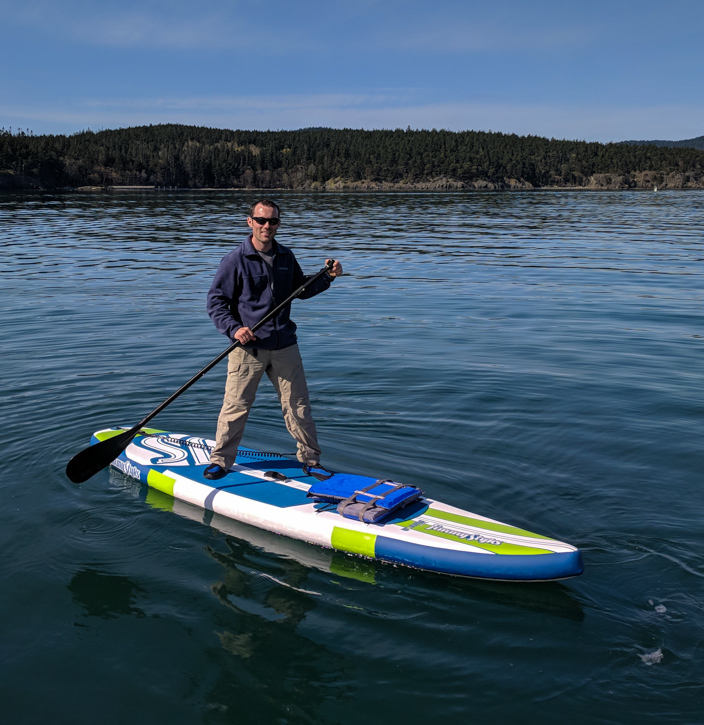
Warm and sunny paddleboarding at Decatur Head on the last day in March
We had checked out the west cove of James Island for anchoring, but it’s pretty deep (50′ with 35′ only close to the dock pilings). The park dock is not yet deployed. The next day we took our dinghy over to James Island though and hiked around it.

Exploring the pirate ship and other oddities on the beach at Decatur Head
Cypress Island, Eagle Harbor
We sailed east to Cypress, our favorite island for hiking, in a 15 knot southerly that built to 20 with gusts to 25. Around Reef Point, at the southern tip of Cypress, the waves in Rosario Strait had kicked up into 5 foot rollers. Our boat speed hit 7 knots and speed over ground was 8+ knots due to the current!
It made for some fun, tiring sailing. We’re used to Rosario being pretty calm and placid, but it definitely can be serious when a strong southerly wind kicks up against the tail of a big ebb. I had a lot of fun though – feeling our boat power up and really soar is my favorite part of cruising.
We stayed at Cypress for two days and did the 9 mile (roundtrip) hike to Reef Point on the southern tip of the island, and the next day a 6 mile (roundtrip) hike to Cypress Head.
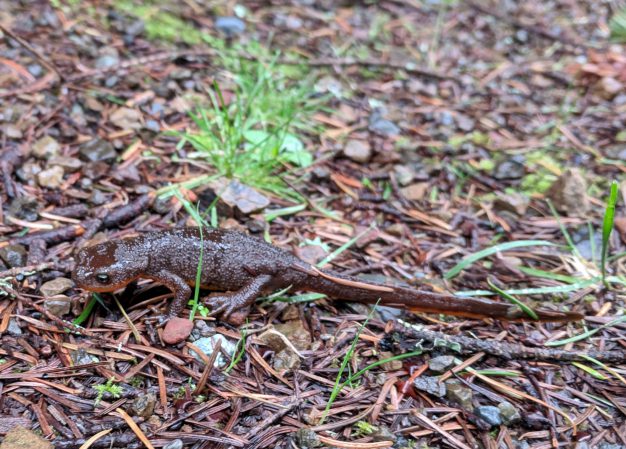
We saw lots of these “rough skinned newts”. They have an orange underbelly. They’re super well camouflaged on the trail and don’t move at all, so we had to pay close attention to avoid stepping on them!
Lummi Island, Inati Bay
We motored east (no wind) to Inati Bay, a tiny nook on the east shore of Lummi Island. We’ve never been to Lummi Island before. Unfortunately, the shore here is privately owned by the Lummi Island Land Company and, according to our Waggoners Guide they used to allow the public on shore but no longer do.
There are signs posted saying private beach, no trespassing. I had thought Washington tidelands below the high water line are public access, but apparently this isn’t quite true – a little research reveals Washington sold many of its tidelands / beaches as private property prior to 1971 [reference, plus further discussion in this forum thread]. Anyway, it’s a little bit sad that so much of Washington’s tidelands were sold to private interests and then go unused most of the year – beach walks seem like they should be retained as a public good.
On the plus side there’s no one here and we have a view of a nice little waterfall on the beach, and the cove is pretty well protected.
Impressions of the San Juans in the Early Season
The San Juans in early April are very different from the islands in the summer. They feel nearly deserted – per day, we see only 1 or 2 sailboats or cruising motorboats. Most of our anchorages have been empty but for us.

Certainly there are more challenges – a low pressure system moved through pretty quickly on Easter Sunday, bringing a gale warning to the JdF and an S.C.A. in the San Juans. We had a graupel sunshower once we arrived at Eagle Harbor on Cypress. But the bad weather is usually short-lived.
We wondered why more people don’t do early season San Juans cruising. In many ways we enjoy the early season rewards and challenges here better than July/August. I suppose the main deterrents are: heating capability (your boat needs a decent heat source for cold nights) and weather (more wind or rain to deal with).

One of the things we love about the San Juans is nearly every island has great hiking. So we’ve been hiking pretty much every day, along trails that take us beside shoreline cliffs, beaches, and panoramic views of the water. With such easy access to amazing hikes we have to remind ourselves not to get too spoiled because great hiking trails are harder to come by once we move further north.

Crossing Rosario Strait under reefed main and reefed genoa in S 15 (later building to S 20, gusts to 25)

We left for our cruise last year in April and have fallen in love with the early season. Have some of the most popular anchorages around all to yourself more than makes up for a little cold and rain. But then,as you said, having lived aboard for a winter ,your sense of appropriate boating temperature does change.
Enjoy it for the next month or two because we noticed that by June 1 the whole experience started to change … not that it was bad… just different.
Great story! I’m jealous of you having left so early, and enjoying places in the islands. I had my best sail across JdF last year in the early season as well. I have also always wanted to try Inati Bay on Lummi as friends have a house there, but was scared away by the lack of anywhere to go on the beach.
Looks like you guys are having a great time! What a great start to the trip
Side note: those are river otters I think, not sea otters (confusingly as they live in the sea)
Oh, good to know. I found a sea otter vs river otter guide on the Seattle Aquarium site and I think I’ll be able to tell the difference now.